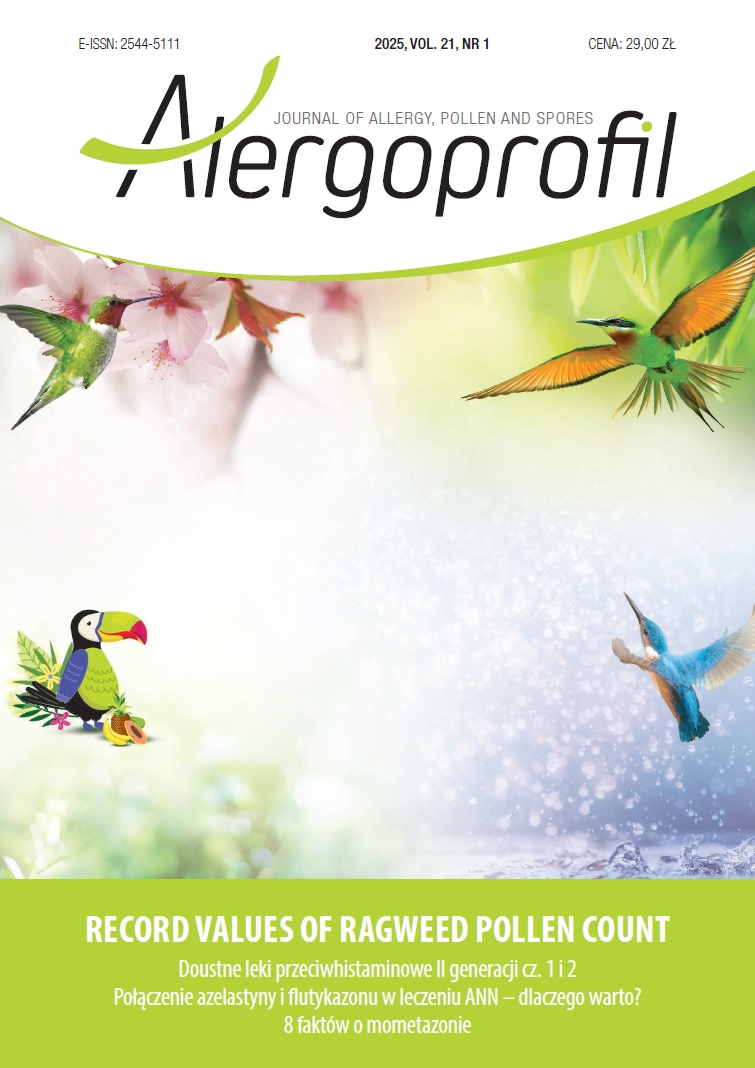Second-generation oral antihistamines: which ones? to whom? – cases Case report
Main Article Content
Abstract
The publication presents three cases of patients with various allergic diseases treated with selected second generation oral antihistamines: bilastine, desloratadine and fexofenadine, with comments.
Downloads
Article Details

This work is licensed under a Creative Commons Attribution-NonCommercial 4.0 International License.
Copyright: © Medical Education sp. z o.o. This is an Open Access article distributed under the terms of the Attribution-NonCommercial 4.0 International (CC BY-NC 4.0). License (https://creativecommons.org/licenses/by-nc/4.0/), allowing third parties to copy and redistribute the material in any medium or format and to remix, transform, and build upon the material, provided the original work is properly cited and states its license.
Address reprint requests to: Medical Education, Marcin Kuźma (marcin.kuzma@mededu.pl)
References
2. Arcimowicz M. Alergiczny nieżyt nosa – skuteczne leczenie według najnowszych zaleceń. Otolaryng Pol. 2022; 76: 45-59.
3. Zuberbier T, Aberer W, Bernstein JA et al. Wytyczne EAACI/ GA2LEN/EDF/WAO dotyczące definicji, klasyfikacji, diagnostyki i leczenia pokrzywki. Alergologia Polska – Polish Journal of Allergology. 2020; 7(1): 1-28.
4. Zuberbier T, Balke M, Worm M et al. Epidemiology of urticaria: a representative cross-sectional population survey. Clin Exp Dermatol. 2010; 35: 869-73.
5. Raciborski F, Kłak A, Czarnecka-Operacz M et al. Epidemiology of urticaria in Poland – nationally representative survey results. Adv Dermatol Allergol. 2018; 35: 67-73.
6. Ryan D, Tanno LK, Angier E et al. Clinical review: The suggested management pathway for urticaria in primary care. Clin Transl Allergy. 2022; 12: e12195.
7. Kaplan A, Lebwohl M, Giménez-Arnau AM et al. Chronic spontaneous urticaria: Focus on pathophysiology to unlock treatment advances. Allergy. 2023; 78: 389-401.
8. Zuberbier T, Altrichter S, Bauer S et al. S3 Guideline Urticaria. Part 2: Treatment of urticaria – German-language adaptation of the international S3 guideline. J Dtsch Dermatol Ges. 2023; 21: 202-215.
9. Bilastine FDA Approval Status.
10. Roberts G, Xatzipsalti M, Borrego LM et al. Paediatric rhinitis: position paper of the European Academy of Allergy and Clinical Immunology. Allergy. 2013; 68: 1102-16.
11. Sikorska-Szaflik H, Sozańska B. Quality of life in allergic rhinitis – children’s and their parents’ perspective in polish urban and rural population. Health Qual Life Outcomes. 2020; 18: 64.
12. Diniz AF, Ribeiro JA, Lira GV et al. Allergic rhinitis in preschoolers: a systematic review of diagnostics. Am J Rhinol Allergy. 2023; 37: 360-8.
13. Brożek JL, Bousquet J, Agache I et al. Allergic rhinitis and its impact on asthma (ARIA) guidelines – 2016 revision. J Allergy Clin Immunol. 2017; 140: 950-8.
14. Mazurek H. Czy dopuszcza się stosowanie glikokortykosteroidów donosowo u dzieci <5. roku życia? .
15. Scadding GK, Smith PK, Blaiss M et al. Allergic rhinitis in childhood and the new EUFOREA algorithm. Front Allergy. 2021; 2: 706589.
16. Charakterystyka produktu leczniczego. Delortan.
17. Aplikacja Momester.
18. Krzych-Fałta E, Samoliński B. Alergiczny nieżyt nosa – problem bio-psycho-społeczny w aspekcie funkcjonowania rodziny. Pielęg Pol. 2013; 28: 100-4.
19. Jacobs TS, Forno E, Brehm JM et al. Underdiagnosis of allergic rhinitis in underserved children. J Allergy Clin Immunol. 2014; 134: 737-9.
20. Hellings PW, Scadding G, Bachert C et al. EUFOREA treatment algorithm for allergic rhinitis. Rhinology. 2020; 58: 618-22.
21. Meltzer EO. Quality of life in adults and children with allergic rhinitis. J Allergy Clin Immunol. 2001; 108: S45-53.
22. Bosnic-Anticevich S, Smith P, Abramson M et al. Impact of allergic rhinitis on the day-to-day lives of children: insights from an Australian cross-sectional study. BMJ Open. 2020; 10: e038870.
23. Colas C, Galera H, Anibarro B et al. Disease severity impairs sleep quality in allergic rhinitis (The SOMNIAAR study). Clin Exp Allergy. 2012; 42: 1080-7.
24. Pagel JML, Mattos JL. Allergic Rhinitis and Its Effect on Sleep. Otolaryngol Clin North Am. 2024; 57: 319-28.
25. Zhu X, Lv Q. Association and mechanism of montelukast on sleep disorders: insights from NHANES 2005-2018 data analysis and a network pharmacology study. J Asthma. 2025 Jan 17: 1-10.
26. Meeves SG, Appajosyula S. Efficacy and safety profile of fexofenadine HCl: a unique therapeutic option in H1-receptor antagonist treatment. J Allergy Clin Immunol. 2003; 112(4 Suppl): S69-77.
27. Naclerio RM, Ansotegui IJ, Canonica GW et al. Twenty-five years: The fexofenadine clinical experience. World Allergy Organ J. 2024; 17: 100950.
28. Ansotegui IJ, Bousquet J, Canonica GW et al. Why fexofenadine is considered as a truly non-sedating antihistamine with no brain penetration: a systematic review. Curr Med Res Opin. 2024; 40: 1297-1309.
29. Charakterystyka produktu leczniczego. Telfexo.
30. Ciprandi G, Tosca MA, Cosentino C et al. Effects of fexofenadine and other antihistamines on components of the allergic response: adhesion molecules. J Allergy Clin Immunol. 2002; 112: S78-82.
31. Ellis AK, Murrieta-Aguttes M, Furey S et al. Effect of fexofenadine hydrochloride on allergic rhinitis aggravated by air pollutants. ERJ Open Res. 2021; 7: 00806-2020.
32. Rapiejko P. Elektroniczne kwestionariusze monitorujące objawy ułatwią diagnostykę i leczenie alergicznego nieżytu nosa. Alergoprofil. 2016; 12: 153-9.
33. Bousquet J, Devillier P, Arnavielhe S et al. Treatment of allergic rhinitis using mobile technology with real-world data: The MASK observational pilot study. Allergy. 2018; 73: 1763-74.
